四川大学数据结构实验Lab4_2
川师数学院数据结构试验报告资料

char data[QueueSize];
int front,rear;
}SqQueue;
void InitQueue(SqQueue &qu)
{
= =0;
}
status EnQueue(SqQueue &qu,char x)
{
if( +1)%QueueSize==
return 0;
=+1)%QueueSize;
{
if (!In(c,OP)){Push(OPND,c);c=getchar();}
else
switch(Precede(GetTop(OPTR),c))
{
case '<' : Push(OPTR,c); c = getchar();
break;
case '=' : Pop(OPTR,c); c = getchar();
3.编写实验报告。
实验结果:入程序代码并进行调试和算法分析;
2.编写实验报告。
实验结果:
入程序代码并进行调试和算法分析;2.编写实验报告。
实验结果:
(1)/*队列存储*/
#include ""
typedef int status;
#define QueueSize 10
typedef struct sqqueue
GetHead(qu,e);
printf("Queue of top elem is: %c\n",e);
printf("show of Queue:\n");
while(!QueueEmpty(qu))
{
数据结构lab04
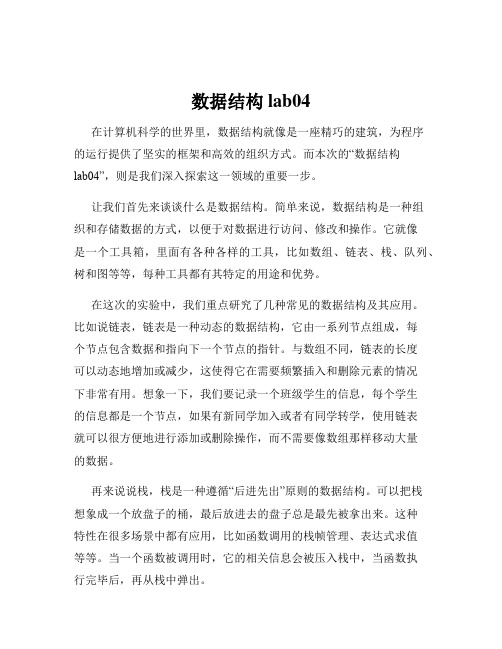
数据结构lab04在计算机科学的世界里,数据结构就像是一座精巧的建筑,为程序的运行提供了坚实的框架和高效的组织方式。
而本次的“数据结构lab04”,则是我们深入探索这一领域的重要一步。
让我们首先来谈谈什么是数据结构。
简单来说,数据结构是一种组织和存储数据的方式,以便于对数据进行访问、修改和操作。
它就像是一个工具箱,里面有各种各样的工具,比如数组、链表、栈、队列、树和图等等,每种工具都有其特定的用途和优势。
在这次的实验中,我们重点研究了几种常见的数据结构及其应用。
比如说链表,链表是一种动态的数据结构,它由一系列节点组成,每个节点包含数据和指向下一个节点的指针。
与数组不同,链表的长度可以动态地增加或减少,这使得它在需要频繁插入和删除元素的情况下非常有用。
想象一下,我们要记录一个班级学生的信息,每个学生的信息都是一个节点,如果有新同学加入或者有同学转学,使用链表就可以很方便地进行添加或删除操作,而不需要像数组那样移动大量的数据。
再来说说栈,栈是一种遵循“后进先出”原则的数据结构。
可以把栈想象成一个放盘子的桶,最后放进去的盘子总是最先被拿出来。
这种特性在很多场景中都有应用,比如函数调用的栈帧管理、表达式求值等等。
当一个函数被调用时,它的相关信息会被压入栈中,当函数执行完毕后,再从栈中弹出。
队列则是遵循“先进先出”原则的数据结构,就像排队买票一样,先到的人先得到服务。
队列在很多地方都有应用,比如操作系统中的任务调度、消息队列等。
除了这些基本的数据结构,我们还探讨了树和图。
树是一种分层的数据结构,比如二叉树、二叉搜索树等。
二叉搜索树的特点是左子树中的节点值都小于根节点,右子树中的节点值都大于根节点,这使得查找、插入和删除操作的效率都很高。
图则是由节点和边组成的数据结构,可以用来表示各种复杂的关系,比如交通网络、社交网络等。
在实验过程中,我们通过实际的代码实现来加深对这些数据结构的理解。
比如说,我们用 C 语言或者 Java 语言来实现一个链表,包括创建节点、插入节点、删除节点等操作。
川大数据结构课程设计
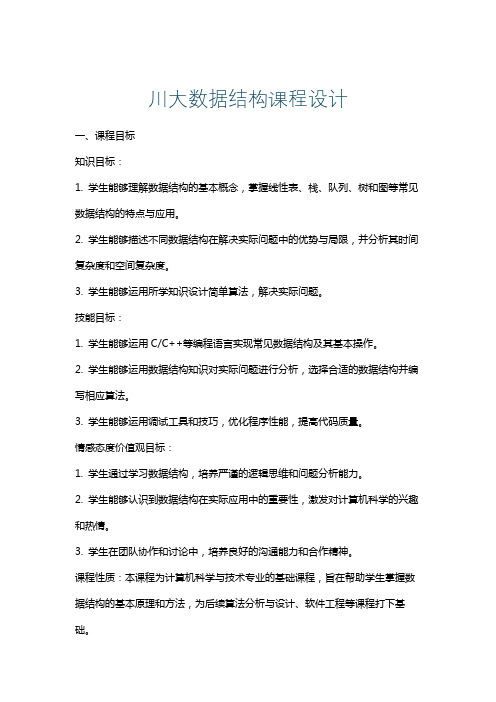
川大数据结构课程设计一、课程目标知识目标:1. 学生能够理解数据结构的基本概念,掌握线性表、栈、队列、树和图等常见数据结构的特点与应用。
2. 学生能够描述不同数据结构在解决实际问题中的优势与局限,并分析其时间复杂度和空间复杂度。
3. 学生能够运用所学知识设计简单算法,解决实际问题。
技能目标:1. 学生能够运用C/C++等编程语言实现常见数据结构及其基本操作。
2. 学生能够运用数据结构知识对实际问题进行分析,选择合适的数据结构并编写相应算法。
3. 学生能够运用调试工具和技巧,优化程序性能,提高代码质量。
情感态度价值观目标:1. 学生通过学习数据结构,培养严谨的逻辑思维和问题分析能力。
2. 学生能够认识到数据结构在实际应用中的重要性,激发对计算机科学的兴趣和热情。
3. 学生在团队协作和讨论中,培养良好的沟通能力和合作精神。
课程性质:本课程为计算机科学与技术专业的基础课程,旨在帮助学生掌握数据结构的基本原理和方法,为后续算法分析与设计、软件工程等课程打下基础。
学生特点:大一、大二学生,具备一定的编程基础,对数据结构有一定了解,但尚不深入。
教学要求:注重理论与实践相结合,通过案例分析和实际编程,使学生更好地理解和掌握数据结构知识。
同时,注重培养学生的逻辑思维和问题解决能力,提高其计算机素养。
二、教学内容1. 线性表:介绍线性表的定义、特点和基本操作,包括顺序存储和链式存储结构,分析其优缺点及适用场景。
教材章节:第2章 线性表内容安排:2学时2. 栈与队列:讲解栈和队列的基本概念、操作及应用,分析其时间复杂度和空间复杂度。
教材章节:第3章 栈和队列内容安排:2学时3. 树与二叉树:阐述树和二叉树的基本概念、性质、存储结构及遍历方法,介绍哈夫曼树、平衡二叉树等特殊树及其应用。
教材章节:第4章 树和二叉树内容安排:4学时4. 图:介绍图的定义、存储结构、遍历方法以及最小生成树、最短路径等算法。
教材章节:第5章 图内容安排:4学时5. 排序算法:讲解常见排序算法,如冒泡排序、插入排序、快速排序等,分析其时间复杂度和稳定性。
数据结构与算法分析实验报告(川大)
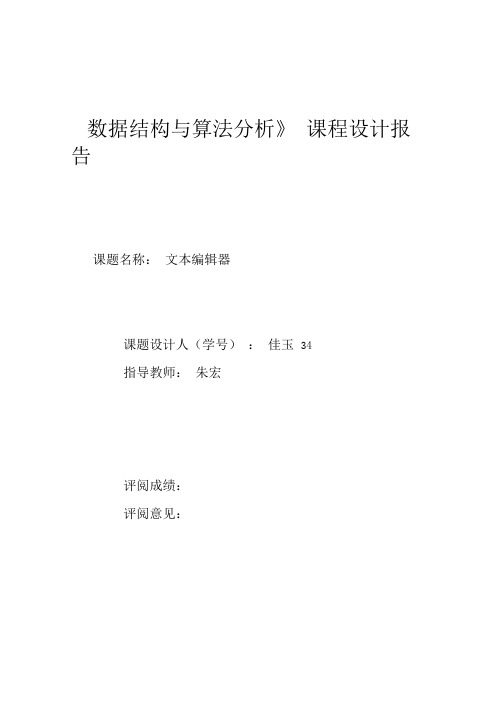
数据结构与算法分析》课程设计报告课题名称:文本编辑器课题设计人(学号):佳玉34指导教师:朱宏评阅成绩:评阅意见:提交报告时间:20 13 年12 月22 日文本编辑器计算机科学与技术专业学生佳玉指导老师朱宏[ 摘要] 文本编辑器(或称文字编辑器)是用作编写普通文字的应用软件,它与文档编辑器(或称文字处理器)不同之处在于它并非用作桌面排版(例如文档格式处理)。
它常用来编写程序的源代码。
专业的计算机用户使用的文本编辑器往往不限制打开文件的大小。
这样的编辑器在编辑大文件时,启动仍然很快,而且它们还能够编辑超过存大小的文件。
而简单的文本编辑器通常直接把文件读至存。
这样在处理较大文件时速度较慢,对于更大的文件,则干脆无法处理。
我所做的这个文本编辑器包含插入、移除、替换、查找、显示和新建的功能,是一种简单的文本编辑器。
关键词:简单的文本编辑器插入移除替换查找显示新建一、实验名称:文本编辑器二、实验的目的和要求:1.采用C++的ASCII 码文件和串函数实现;2.熟练掌握串运算的应用;3.熟练掌握计算机系统的基本操作方法, 了解如何编辑、编译、和运行一个C++程序;4.上机调试程序, 掌握查错、排错使程序能正确运行。
三、实验的环境: 指硬件和软件环境1.硬件环境: G405+4G存+320G硬盘+川大校园网2.软件环环境:操作系统:Windows 7编译系统的版本的特点:Dev-C++是一套用于开发C/C++的自由的集成开发环境( IDE),并以GPL作为散布许可。
使用MinGW 及GDB 作为编译系统与除错系统。
Dev-C++的IDE 是利用Delphi 开发的。
编辑软件特点:包含强大的类和嵌WinAPI 的MFC,具有可视化的编程界面。
四、算法描述:1、用户可以选择自己输入文本或者直接使用程序以初始化的文本,用switch case 语句就可以根据用户不同的选择执行相应的代码。
相应代码:cout<<"a 代表自己输入文本,b 代表使用电脑设置的文本"<<endl; cout<<" 请输入你的选择:"<<endl;char ch;cin>>ch;switch(ch)// 对用户的不同选择执行不同的代码{case 'a':// 当用户选择自行输入文本时break;case 'b':// 当用户选择使用电脑设置的文本时break;}2、当用户选择自己输入文本时,就需要写一些函数来存储这些信息,可以将这些函数封装在一个模板类中,只要定义一个之歌类的对象( bianji )就可以在需要的时候调用类的函数。
Lab4 介绍
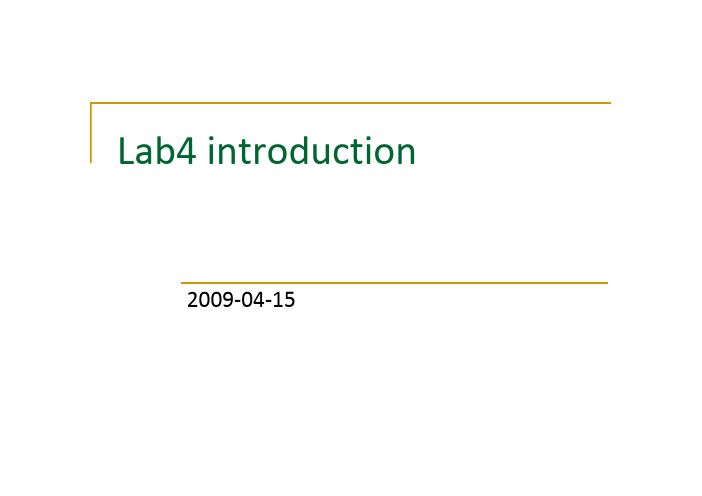
3. 使用PDX(VPT)在页目录在查找,得到一个特殊的页
表(SPT)——页目录本身 (自映射的作用)
4. 使用PDX(addr)在SPT(也就是页目录)里找到一个特 殊的页(SPage)——实际上是页表
5. 使用PTX(addr)|00得到页表项
fork() vs dumb_fork()
dumb_fork
dumbfork
一个古老的fork,采用复制地址空间的内容的方法 创建子进程
user/dumbfork.c
fork
实现了copy‐on‐write的fork函数 lib/fork.c
dumbfork流程
1. sys_exofork
env_alloc eax (0) Status (ENV_NOT_RUNNABLE)
关键点
curenv全局变量
在运行第一个用户进程之前,curenv的值为NULL
调度过程
调度过程
envs[1]、envs[2]… envs[NENV‐1]形成一个逻辑 上的环状结构
如果curenv==NULL,就从envs[1]开始检查;否 则就从curenv指向的Env结构的下一个envs数 组元素开始检查。从环上寻找第一个状态为 ENV_RUNNABLE的进程
利用一些系统调用来实现一个用户空间的、写 时复制的库函数fork
用户创建进程相关的系统调用:
sys_exofork sys_env_set_status sys_page_alloc sys_page_map sys_page_unmap
fork()的流程
1. set_pgfault_handler 2. sys_exofork
四川大学网络学院-数据结构课程设计-参考答案

四川大学《数据结构》课程设计实验项目及内容提要(实验任选一个完成)
试读3页
数据结构实验报告
实验名称: Huffman编码(二叉树应用)
提交文档学生姓名:
提交文档学生学号:
同组成员名单:无
指导教师姓名:
指导教师评阅成绩:
指导教师评阅意见:
.
.
提交报告时间: 2020 年 3 月 26 日
目录
一、概述 (1)
二、系统分析 (1)
三、概要设计 (2)
四、详细设计 (4)
4.1 赫夫曼树的建立 (4)
4.1.1 选择选择parent 为0 且权值最小的两个根结点的算
法 (5)
4.1.2 统计字符串中字符的种类以及各类字符的个数 (7)
4.1.3构造赫夫曼树 (8)
4.2赫夫曼编码 (10)
4.2.1赫夫曼编码算法 (10)
4.2.2建立正文的编码文件 (11)
4.3代码文件的译码 (12)
五、运行与测试 (14)
六、总结与心得 (14)
参考文献................................. 错误!未定义书签。
附录..................................... 错误!未定义书签。
数据结构 实验报告
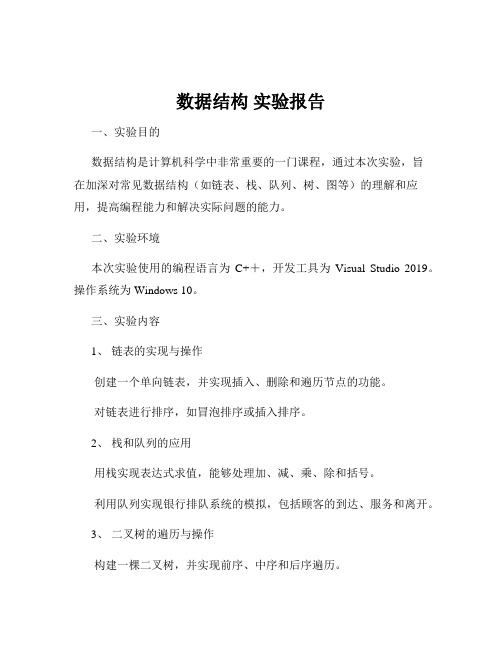
数据结构实验报告一、实验目的数据结构是计算机科学中非常重要的一门课程,通过本次实验,旨在加深对常见数据结构(如链表、栈、队列、树、图等)的理解和应用,提高编程能力和解决实际问题的能力。
二、实验环境本次实验使用的编程语言为C++,开发工具为Visual Studio 2019。
操作系统为 Windows 10。
三、实验内容1、链表的实现与操作创建一个单向链表,并实现插入、删除和遍历节点的功能。
对链表进行排序,如冒泡排序或插入排序。
2、栈和队列的应用用栈实现表达式求值,能够处理加、减、乘、除和括号。
利用队列实现银行排队系统的模拟,包括顾客的到达、服务和离开。
3、二叉树的遍历与操作构建一棵二叉树,并实现前序、中序和后序遍历。
进行二叉树的插入、删除节点操作。
4、图的表示与遍历用邻接矩阵和邻接表两种方式表示图。
实现图的深度优先遍历和广度优先遍历。
四、实验步骤及结果1、链表的实现与操作首先,定义了链表节点的结构体:```cppstruct ListNode {int data;ListNode next;ListNode(int x) : data(x), next(NULL) {}};```插入节点的函数:```cppvoid insertNode(ListNode& head, int val) {ListNode newNode = new ListNode(val);head = newNode;} else {ListNode curr = head;while (curr>next!= NULL) {curr = curr>next;}curr>next = newNode;}}```删除节点的函数:```cppvoid deleteNode(ListNode& head, int val) {if (head == NULL) {return;}ListNode temp = head;head = head>next;delete temp;return;}ListNode curr = head;while (curr>next!= NULL && curr>next>data!= val) {curr = curr>next;}if (curr>next!= NULL) {ListNode temp = curr>next;curr>next = curr>next>next;delete temp;}}```遍历链表的函数:```cppvoid traverseList(ListNode head) {ListNode curr = head;while (curr!= NULL) {std::cout << curr>data <<"";curr = curr>next;}std::cout << std::endl;}```对链表进行冒泡排序的函数:```cppvoid bubbleSortList(ListNode& head) {if (head == NULL || head>next == NULL) {return;}bool swapped;ListNode ptr1;ListNode lptr = NULL;do {swapped = false;ptr1 = head;while (ptr1->next!= lptr) {if (ptr1->data > ptr1->next>data) {int temp = ptr1->data;ptr1->data = ptr1->next>data;ptr1->next>data = temp;swapped = true;}ptr1 = ptr1->next;}lptr = ptr1;} while (swapped);}```测试结果:创建了一个包含 5、3、8、1、4 的链表,经过排序后,输出为 1 3 4 5 8 。
天大数据结构_实验作业二_栈(顺序栈)+队列(循环队列)
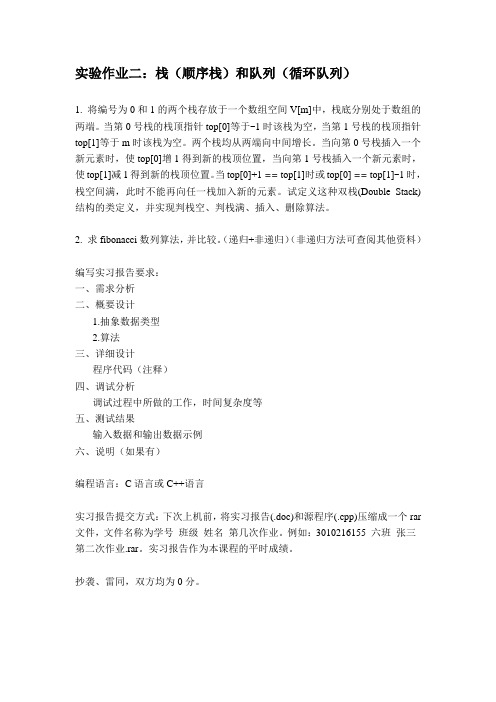
实验作业二:栈(顺序栈)和队列(循环队列)1. 将编号为0和1的两个栈存放于一个数组空间V[m]中,栈底分别处于数组的两端。
当第0号栈的栈顶指针top[0]等于-1时该栈为空,当第1号栈的栈顶指针top[1]等于m时该栈为空。
两个栈均从两端向中间增长。
当向第0号栈插入一个新元素时,使top[0]增1得到新的栈顶位置,当向第1号栈插入一个新元素时,使top[1]减1得到新的栈顶位置。
当top[0]+1 == top[1]时或top[0] == top[1]-1时,栈空间满,此时不能再向任一栈加入新的元素。
试定义这种双栈(Double Stack)结构的类定义,并实现判栈空、判栈满、插入、删除算法。
2. 求fibonacci数列算法,并比较。
(递归+非递归)(非递归方法可查阅其他资料)编写实习报告要求:一、需求分析二、概要设计1.抽象数据类型2.算法三、详细设计程序代码(注释)四、调试分析调试过程中所做的工作,时间复杂度等五、测试结果输入数据和输出数据示例六、说明(如果有)编程语言:C语言或C++语言实习报告提交方式:下次上机前,将实习报告(.doc)和源程序(.cpp)压缩成一个rar 文件,文件名称为学号_班级_姓名_第几次作业。
例如:3010216155_六班_张三_第二次作业.rar。
实习报告作为本课程的平时成绩。
抄袭、雷同,双方均为0分。
第一题:一、需求分析程序要求建立一个共享栈,分配一个存储空间,两个栈分别位于两头。
并实现对两个栈的插入,删除,和判断栈满和栈空。
栈的位置不同,所以要求对不同栈的插入和删除采用不同的算法。
二、概要设计1.抽象数据类型typedef struct {int *base;int *top;int stacksize;}stack;2.算法1.建立栈。
int instack(stack &s,stack &w,int length){s.base=(int *)malloc(length*sizeof(length));w.base=s.base+length;if(!s.base||!w.base) return 0;else{s.top=s.base;w.top=w.base;s.stacksize=length;w.stacksize=length;}return 1;}2.判断栈空。
数据结构实验二
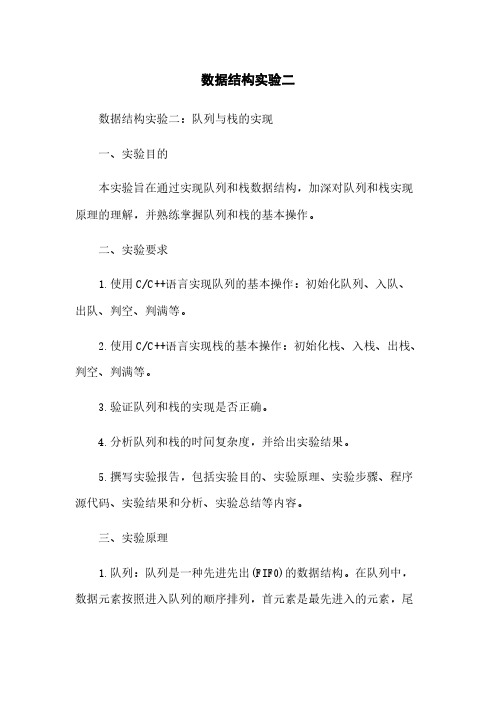
数据结构实验二数据结构实验二:队列与栈的实现一、实验目的本实验旨在通过实现队列和栈数据结构,加深对队列和栈实现原理的理解,并熟练掌握队列和栈的基本操作。
二、实验要求1.使用C/C++语言实现队列的基本操作:初始化队列、入队、出队、判空、判满等。
2.使用C/C++语言实现栈的基本操作:初始化栈、入栈、出栈、判空、判满等。
3.验证队列和栈的实现是否正确。
4.分析队列和栈的时间复杂度,并给出实验结果。
5.撰写实验报告,包括实验目的、实验原理、实验步骤、程序源代码、实验结果和分析、实验总结等内容。
三、实验原理1.队列:队列是一种先进先出(FIF0)的数据结构。
在队列中,数据元素按照进入队列的顺序排列,首元素是最先进入的元素,尾元素是最后进入的元素。
队列的基本操作有:初始化队列、入队、出队、判空、判满等。
2.栈:栈是一种后进先出(LIFO)的数据结构。
在栈中,数据元素按照进入栈的顺序排列,但是只能从栈顶进出,即最后进入的元素最先出栈。
栈的基本操作有:初始化栈、入栈、出栈、判空、判满等。
四、实验步骤1.实现队列的基本操作:1.初始化队列:创建一个空队列,并设置相关指针。
2.入队:将新元素插入到队尾。
3.出队:将队头元素删除,并返回其值。
4.判空:判断队列是否为空。
5.判满:判断队列是否已满。
2.实现栈的基本操作:1.初始化栈:创建一个空栈,并设置相关指针。
2.入栈:将新元素压入栈顶。
3.出栈:将栈顶元素弹出,并返回其值。
4.判空:判断栈是否为空。
5.判满:判断栈是否已满。
3.编写测试代码,验证队列和栈的基本操作是否正确。
4.进行性能测试,分析队列和栈的时间复杂度。
五、实验结果与分析1.队列的时间复杂度:●初始化队列:O(1)●入队:O(1)●出队:O(1)●判空:O(1)●判满:O(1)2.栈的时间复杂度:●初始化栈:O(1)●入栈:O(1)●出栈:O(1)●判空:O(1)●判满:O(1)3.根据实验结果可以看出,队列和栈的基本操作的时间复杂度都是O(1),即常数时间复杂度,具有高效性。
数据结构实验指导书及其答案pdf
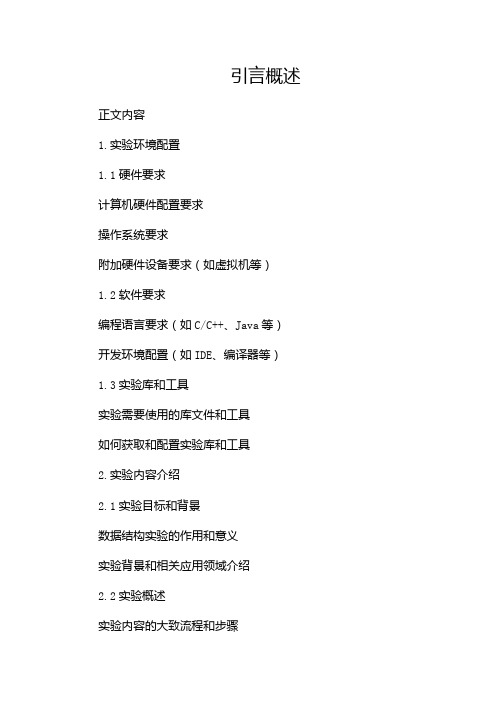
引言概述正文内容
1.实验环境配置
1.1硬件要求
计算机硬件配置要求
操作系统要求
附加硬件设备要求(如虚拟机等)
1.2软件要求
编程语言要求(如C/C++、Java等)开发环境配置(如IDE、编译器等)1.3实验库和工具
实验需要使用的库文件和工具
如何获取和配置实验库和工具
2.实验内容介绍
2.1实验目标和背景
数据结构实验的作用和意义
实验背景和相关应用领域介绍
2.2实验概述
实验内容的大致流程和步骤
实验中可能遇到的问题和挑战
2.3实验要求
对学生实验流程和实验结果的要求
实验过程中需要注意的事项和技巧
3.实验步骤
3.1实验准备
配置实验环境
获取实验所需数据和文件
3.2实验具体步骤
根据实验要求将数据结构知识应用到具体问题中根据实验要求实现相应的算法和数据结构
3.3实验示例代码
提供示例代码以供学生参考和学习
解析示例代码中的关键步骤和实现细节
4.实验答案
4.1实验题目
实验题目及相关说明
确定实验的具体要求和目标
4.2实验答案解析
对实验答案的具体实现进行解析
对实验中可能遇到的问题和错误进行分析和解决4.3实验答案示例
提供实验答案的示例代码
解析实验答案中的关键实现步骤和说明
5.实验总结
5.1实验成果评估
对学生实验成果进行评估
分析实验结果的优点和不足
5.2实验心得
学生对本次实验的收获和感想
学生对未来实验的建议和展望
总结。
四川大学商学院 数据结构实验大纲(2015)

课程实验教学大纲2014——20152学期四川大学商学院实验中心制2015年2月第 2 页共7 页说明1、首页“文档版本号”是为了备查而对大纲进行的编号,编号形式为“YYNNN.MM”。
其中“YYNNN”为主版本号,“YY”为年号,“NNN”为流水号,“MM”为副版本号,如果大纲变动不大,则只递增副版本号,编号不足部分用0补齐。
2、首页“教师名称”中建议附加教师的联系电话。
3、文档中的为注释文字,在大纲具体编制时,应改为黑色5号正宋体。
4、大纲编制人应认真填写“应配备的主要设备名称和台件数”以便实验室工作人员提前做好准备。
5、实验大纲应提前一学期交教务部、实验中心备案,以便安排相关准备工作。
课程实验大纲课程实验大纲一、实验性质、目的和要求1、实验性质:非独立设课。
2、实验目的和要求与课堂上的教学密切结合,使学生不但掌握ADT的理论,会分析现有的算法,还必须具备自己动手实践的能力。
通过实验课的教学,学会创建灵活、实用的ADT。
本课程要求同学先修过C语言。
(1)掌握各章出现的常用ADT的表示和实现方法;(2)了解一些教材中出现复杂的算法的实现原理;(3)熟悉创建ADT的过程。
二、适用专业工业工程、电子商务、管理科学三、学时学分四、实验教学基本要求要求实验课程上课机房事先有安装C语言,建议使用TC3.0及以上版本。
五、实验项目名称和学时分配六、实验课考核方式:1、实验报告在每次实验的开始、进行、结束三阶段,按照学院公布的统一格式完成实验报告的填写。
2、考核方式(1)根据实验结果和学生上交报告综合考核;(2)实验课成绩占课程总成绩算的比例为30%。
七、实验教科书、参考书1、实验指导书自编教材,黄勇,商学院,2015年。
2、参考书《数据结构》(C 语言版),严蔚敏,清华大学出版社。
数据结构,C++语言描述,Willam Ford, 清华大学出版社。
第 4 页共7 页附2 实验指导书实验一线性表一、实验目的通过编制顺序表、链表的程序,掌握线性表的基本操作如插入、删除,能使用顺序表、链表进行应用,解决实际问题如集合的并、交、补等。
数据结构实验报告_9
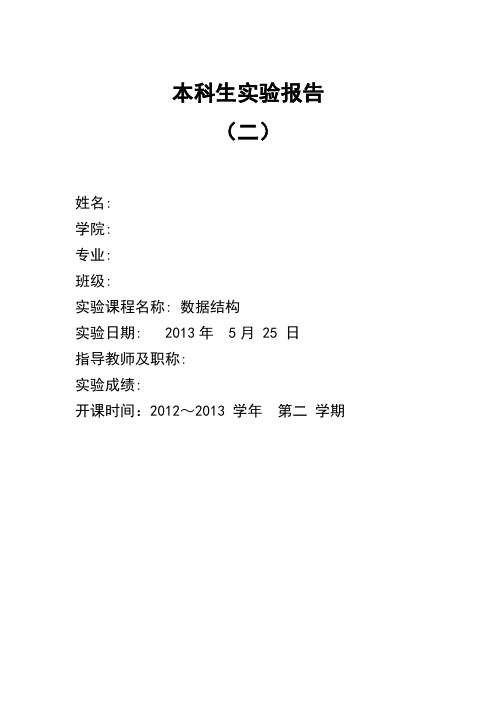
本科生实验报告(二)姓名:学院:专业:班级:实验课程名称: 数据结构实验日期: 2013年 5月 25 日指导教师及职称:实验成绩:开课时间:2012~2013 学年第二学期k++;a[j][n-i-1]=k;}for (j=n-i-2;j>=i;j--){k++;a[n-i-1][j]=k;}for (j=n-i-2;j>=i+1;j--){k++;[j][i]=k;}}}void main(){int n,i,j;int a[MaxLen][MaxLen];printf("输入n(n<10):");scanf("%d",&n);fun(a,n);printf("%d阶数字方阵如下:\n",n);for (i=0;i<n;i++){for (j=0;j<n;j++)printf("%4d",a[i][j]);printf("\n");}}运行结果:6.2:如果矩阵A中存在这样的一个元素A[i][j]满足条件:A[i][j]是第i行中值最小的元素,且又是第j列中值最大的元素,则称为该矩阵的一个马鞍点。
设计一个程序exp6-2.cpp 计算出m*n的矩阵A的所有马鞍点。
主程序如下:6.3:已知A和B为两个n*n阶的对称矩阵,输入时,对称矩阵只输入下三角形元素,存入一维数组,如图6.5所示(对称矩阵M存储在一维数组A中),设计一个程序exp6-3.cpp 实习如下功能:(1)求对称矩阵A和B的和。
(2)求对称矩阵A和B的乘积。
A:图6.5 对称矩阵的存储转换形式主程序如下:#include <stdio.h>#define N 4#define M 10int value(int a[],int i,int j){if (i>=j)return a[(i*(i-1))/2+j];elsereturn a[(j*(j-1))/2+i];}void madd(int a[],int b[],int c[][N]){int i,j;for (i=0;i<N;i++)printf("a+b:\n");disp2(c1);printf("a×b:\n");disp2(c2);printf("\n");}运行结果:6.4::假设n*n的稀疏矩阵A采用三元组表示,设计一个程序exp6-4.cpp实现如下功能:(1)生成如下两个稀疏矩阵矩阵的三元组a和b:(2)输出a转置矩阵的三元组;(3)输出a+b的三元组;(4)输出a*b的三元组。
四川大学数据结构实验Lab4_1

四川⼤学数据结构实验Lab4_1Create a Use-Case Diagram4-1Lab 4-1Create a Use-Case DiagramIn this lab, you will model a use-case diagram in the following two ways:An actor and all its use casesOne use case and all its relationshipsYou will also attach flow of events (use-case specifications) to individual use cases and a project artifact that supports the use-case model. Attaching this documentation helps maintain traceability between the use-case model and requirements and can be directly accessed from the Rational Rose tool.Before You BeginDo not begin this lab until you’ve completed the appropriate information in Module 4: The Use-Case Model in the Student Manual.ObjectiveIn Lab 4-1, you ’ll do the following tasks to create the use-case diagrams and attach the supporting artifacts: 1. Add use-case diagrams to the browser. 2. Add actors and use cases to the diagram. 3. Attach use-case flows of events. 4. Attach a project artifact.Fundamentals of Rational Rose Student Workbook4-2Lab OutcomeTwo completed use-case diagrams showing different aspects of the use-case model and important artifacts attached that support the use-case modelLab ArtifactsUse-Case Diagram (Global View) Supporting artifacts (text files) Lab4_1.mdl fileLab4_2.mdl fileFundamentals of Rational Rose Student Workbook Use-Case Diagram (Global View)4-3Fundamentals of Rational Rose Student Workbook4-4Task 1: Add the Use-Case Diagrams to the BrowserWe are using a modified Rational Unified Process framework and have already added our actors and use cases under the Actors and Use Cases packages respectively. Work from the diagram on the previous page.Steps Comments1.Open Lab4_1.mdl. In the browser,expand the Use Case View and then expand the Use-Case Model package. Take a moment to look at the actors under the Actors package and the use cases under the Use Cases package.2. Create two new use-case diagrams underthe Use-Case model package in thebrowser, and name one Realtor View and the other Maintain Personal Planner View .We are creating a use-case diagram that shows a single actor and all its use cases (Realtor actor) and another that shows a single use case and all its relationships(Maintain Personal Planner use case).See the figure below.3. Continue to Task 2 on the next page to add actors and use cases to the use-case diagrams.Fundamentals of Rational Rose Student Workbook4-5Task 2: Add the Actors and Use Cases to DiagramSteps Comments 1. Double-click the Realtor View use-casediagram icon in your browser.The diagram window isopened.2. Using the diagram on page 4-3 or the global use-case diagram in your existing model, determine the use cases associated with the Realtor actor. You may have to expand somepackages to find the actors and use cases that you need.3. Drag the Realtor actor and its use casesfrom the browser into the diagram window. Arrange the diagram accordingly.Notice that the association relationships are also added automatically. We already added these relationships when we created the global use-case diagram.4. Repeat steps 1 through 3 for theMaintain Personal Planner use-case diagram. See the figures below.5. Continue to Task 3 on the next page toadd use-case flows of events.Fundamentals of Rational Rose Student Workbook4-6Task 3: Add Use-Case Flow of EventsWe’ll now attach the following use-case flow of events under the appropriate use-case package.Apply For Loan (ApplyForLoan.txt)Maintain Personal Planner (MaintainPersonalPlanner.txt)Search For A Home (SearchForHome.txt)Steps Comments1. Right-click the Apply for Loan use-casepackage, and then click to select a new file.2. From the Rose2002 directory, select theApplyForLoan.txt file to attach it under the use-case package. You can now double-click the file to open it from Rose. 3. Repeat steps 1 and 2 for the two otheruse-case flows of events. See the figure below.4. Continue to Task 4 on the next page toadd the Problem Statement to the use-case model.Fundamentals of Rational Rose Student Workbook4-7Task 4: Add Project ArtifactAttach the Home Realty System’s Problem Statement (ProblemStatement.txt) to the use-case model. Remember that you want to attach this document to the overall use-case model and not to a specific use case.Leave your model file open for Lab 4-2: Create an Activity Diagram.Try These ActivitiesIf there is time, explore the following features in Rational Rose:Add text to the documentation window to describe one of your use-case diagrams.Change the line and/or fill color of a use case.Return to your Student Manual to discuss activity diagrams. Leave your model file open for Lab 4-2: Create an Activity Diagram.Fundamentals of Rational Rose Student Workbook 4-8。
数据结构实验报告

数据结构实验报告一、实验目的数据结构是计算机科学中的重要基础课程,通过实验可以更深入地理解和掌握数据结构的概念、原理和应用。
本次实验的主要目的包括:1、熟悉常见的数据结构,如链表、栈、队列、树和图等。
2、掌握数据结构的基本操作,如创建、插入、删除、遍历等。
3、提高编程能力和解决实际问题的能力,能够运用合适的数据结构解决具体的问题。
二、实验环境本次实验使用的编程语言为C++,开发环境为Visual Studio 2019。
三、实验内容1、链表的实现与操作单向链表的创建、插入和删除节点。
双向链表的实现和基本操作。
循环链表的特点和应用。
2、栈和队列的实现栈的后进先出特性,实现入栈和出栈操作。
队列的先进先出原则,完成入队和出队功能。
3、树的操作二叉树的创建、遍历(前序、中序、后序)。
二叉搜索树的插入、查找和删除操作。
4、图的表示与遍历邻接矩阵和邻接表表示图。
深度优先搜索和广度优先搜索算法的实现。
四、实验步骤及结果1、链表的实现与操作单向链表:首先,定义了链表节点的结构体,包含数据域和指向下一个节点的指针域。
通过创建链表头节点,并使用循环依次插入新节点,实现了链表的创建。
插入节点时,根据指定位置找到插入点的前一个节点,然后修改指针完成插入操作。
删除节点时,同样找到要删除节点的前一个节点,修改指针完成删除。
实验结果:成功创建、插入和删除了单向链表的节点,并正确输出了链表的内容。
双向链表:双向链表节点结构体增加了指向前一个节点的指针。
创建、插入和删除操作需要同时维护前后两个方向的指针。
实验结果:双向链表的各项操作均正常,能够双向遍历链表。
循环链表:使链表的尾节点指向头节点,形成循环。
在操作时需要特别注意循环的边界条件。
实验结果:成功实现了循环链表的创建和遍历。
2、栈和队列的实现栈:使用数组或链表来实现栈。
入栈操作将元素添加到栈顶,出栈操作取出栈顶元素。
实验结果:能够正确进行入栈和出栈操作,验证了栈的后进先出特性。
数据结构实验报告实验1

数据结构实验报告实验1一、实验目的本次实验的主要目的是通过实际操作和编程实现,深入理解和掌握常见的数据结构,如线性表、栈、队列等,并能够运用所学知识解决实际问题。
二、实验环境本次实验使用的编程环境为Visual Studio 2019,编程语言为C++。
三、实验内容与步骤(一)线性表的实现与操作1、顺序表的实现定义一个固定大小的数组来存储线性表的元素。
实现插入、删除、查找等基本操作。
2、链表的实现定义链表节点结构体,包含数据域和指针域。
实现链表的创建、插入、删除、遍历等操作。
(二)栈的实现与应用1、栈的实现使用数组或链表实现栈的数据结构。
实现入栈、出栈、栈顶元素获取等操作。
2、栈的应用利用栈实现表达式求值。
(三)队列的实现与应用1、队列的实现使用循环数组或链表实现队列。
实现入队、出队、队头元素获取等操作。
2、队列的应用模拟银行排队系统。
四、实验结果与分析(一)线性表1、顺序表插入操作:在指定位置插入元素时,需要移动后续元素,时间复杂度为 O(n)。
删除操作:删除指定位置的元素时,同样需要移动后续元素,时间复杂度为 O(n)。
查找操作:可以直接通过索引访问元素,时间复杂度为 O(1)。
2、链表插入操作:只需修改指针,时间复杂度为 O(1)。
删除操作:同样只需修改指针,时间复杂度为 O(1)。
查找操作:需要遍历链表,时间复杂度为 O(n)。
(二)栈1、表达式求值能够正确计算简单的四则运算表达式,如 2 + 3 4。
对于复杂表达式,如(2 + 3) 4,也能得到正确结果。
(三)队列1、银行排队系统模拟了客户的到达、排队和服务过程,能够反映出队列的先进先出特性。
五、实验中遇到的问题及解决方法(一)线性表1、顺序表的空间浪费问题问题描述:当预先分配的空间过大而实际使用较少时,会造成空间浪费。
解决方法:可以采用动态分配空间的方式,根据实际插入的元素数量来调整存储空间。
2、链表的指针操作错误问题描述:在链表的插入和删除操作中,容易出现指针指向错误,导致程序崩溃。
数据结构实验报告
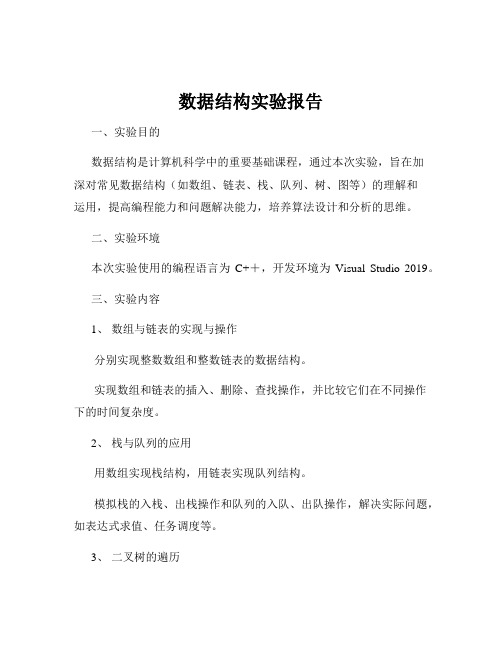
数据结构实验报告一、实验目的数据结构是计算机科学中的重要基础课程,通过本次实验,旨在加深对常见数据结构(如数组、链表、栈、队列、树、图等)的理解和运用,提高编程能力和问题解决能力,培养算法设计和分析的思维。
二、实验环境本次实验使用的编程语言为C++,开发环境为Visual Studio 2019。
三、实验内容1、数组与链表的实现与操作分别实现整数数组和整数链表的数据结构。
实现数组和链表的插入、删除、查找操作,并比较它们在不同操作下的时间复杂度。
2、栈与队列的应用用数组实现栈结构,用链表实现队列结构。
模拟栈的入栈、出栈操作和队列的入队、出队操作,解决实际问题,如表达式求值、任务调度等。
3、二叉树的遍历构建二叉树的数据结构。
实现先序遍历、中序遍历和后序遍历三种遍历算法,并输出遍历结果。
4、图的表示与遍历用邻接矩阵和邻接表两种方式表示图。
实现图的深度优先搜索(DFS)和广度优先搜索(BFS)算法,并分析它们的时间复杂度。
四、实验步骤1、数组与链表数组的实现:定义一个固定大小的整数数组,通过索引访问和操作数组元素。
链表的实现:定义链表节点结构体,包含数据和指向下一个节点的指针。
插入操作:对于数组,若插入位置在末尾,直接赋值;若不在末尾,需移动后续元素。
对于链表,找到插入位置的前一个节点,修改指针。
删除操作:数组需移动后续元素,链表修改指针即可。
查找操作:数组通过索引直接访问,链表需逐个节点遍历。
2、栈与队列栈的实现:用数组模拟栈,设置栈顶指针。
队列的实现:用链表模拟队列,设置队头和队尾指针。
入栈和出栈操作:入栈时,若栈未满,将元素放入栈顶,栈顶指针加 1。
出栈时,若栈不为空,取出栈顶元素,栈顶指针减 1。
入队和出队操作:入队时,在队尾添加元素。
出队时,取出队头元素,并更新队头指针。
3、二叉树构建二叉树:采用递归方式创建二叉树节点。
先序遍历:先访问根节点,再递归遍历左子树,最后递归遍历右子树。
中序遍历:先递归遍历左子树,再访问根节点,最后递归遍历右子树。
- 1、下载文档前请自行甄别文档内容的完整性,平台不提供额外的编辑、内容补充、找答案等附加服务。
- 2、"仅部分预览"的文档,不可在线预览部分如存在完整性等问题,可反馈申请退款(可完整预览的文档不适用该条件!)。
- 3、如文档侵犯您的权益,请联系客服反馈,我们会尽快为您处理(人工客服工作时间:9:00-18:30)。
Create an Activity Diagram4-9 ⎭ ⎭ ⎭ Lab 4-2Create an Activity DiagramIn this lab, you’ll practice creating an activity diagram that shows the workflow for a use case’s basic flow. We will model an activity diagram as it relates to our use-case model, specifically to illustrate the Maintain Personal Planner use case’s basic flow.Before You Begin⎭Make sure you’ve successfully completed Lab 4-1. ⎭ Do not begin this lab until you’ve discussed the appropriate information in Module 4: The Use-Case Model in the Student Manual.ObjectiveIn Lab 4-2, select one of the following options to create an activity diagram. Option 1Look at the Maintain Personal Planner Use-Case Specification on page 4-11 to determine the activities in the basic flow.Option 2Use the Activity Diagram on page 4-12 and follow the existing diagram to create the activity diagram in your model.Lab Outcome⎭ Completed activity diagram showing the Maintain Personal Planner use case’s basic flowFundamentals of Rational Rose Student WorkbookLab Artifacts⎭Maintain Personal Planner Use-Case Specification⎭Activity Diagram⎭Lab4_1.mdl file⎭Lab4_2.mdl file4-10Fundamentals of Rational Rose Student Workbook4-11Maintain Personal Planner Use-Case Specification1. Maintain Personal Planner1.1 Brief DescriptionThis use case allows the Prospective Buyer to set up an account that will store home search preferences, contact information, and other financial or personal information that will aid the Prospective Buyer in finding a home on the web site.2. Flow of Events2.1 Basic FlowThis use case begins when the Prospective Buyer chooses to create a Personal Planner profile.1. The system requests the Prospective Buyer to create a new profile if one does not already exist. Ifa profile does exist, the customer is given the option to log on to the system.2. The system prompts the customer to create a new profile. Profile information includes: name,e-mail address, password, and a preference on receiving marketing news by e-mail.3. The system creates the customer profile using the customer’s e-mail address as his logon ID.When the new profile has been created, an e-mail message will be sent to the customer welcoming him to the system and providing access information and other details that can be changed on an “as-needed” basis.4. The customer enters a default set of home search criteria and saves the information.2.2 Alternative Flows2.2.1 Duplicate Logon ID ExistsIf, in the Basic Flow , the Prospective Buyer enters an e-mail address that already exists, then the system will assume that the user has already created a profile. The system will prompt the customer with a message that a profile already exists for the given e-mail address and asks if the user would like to create a new account using the existing account.2.2.1.1 Prospective Buyer Forgets PasswordIf, in the Basic Flow , the Prospective Buyer forgets his password, the system will allow him to create a new one. The system will prompt the user for his logon ID (e-mail address), and the system will thengenerate a new password and send it to the Prospective Buyer’s e-mail address that is used as the logon ID.2.2.2 Invalid Format or Insufficient InformationIf, in the Basic Flow , the Prospective Buyer has not specified sufficient information to create the customer profile, the system will prompt the actor for the missing information. The Prospective Buyer can either enter the missing information or choose to cancel the operation, at which point the use case ends.3. Special RequirementsNone.4. Pre-ConditionsNone.5. Post-ConditionsNone.6. Extension PointsNone.Fundamentals of Rational Rose Student Workbook Activity Diagram4-12Fundamentals of Rational Rose Student Workbook4-13Task 1: Add Activity Diagram to the BrowserAdd the Maintain Personal Planner activity diagram under its use case in the browser.Steps Comments 1. Make sure Lab4_1.mdl is open. Right-click the Maintain Personal Planner use case, and then click New .Make sure to right-click the use case, NOT the package. 2. Click Activity Diagram and name it Basic Flow .After naming the diagram, click outside the name box.3. Open the new activity diagram. Task 2: Add ActivitiesUsing either the use-case specification on page 4-11 or the Activity Diagram on page 4-12, determine the activities for the use case’s basic flow and add them to the diagram.Task 3: Add Start and End StatesNow, add your start state and end state(s) to the diagram.Hint:⎭ You can have more than one end state, but only one start state.Task 4: Add State Transitions, Decisions and Guard ConditionsFinally, add your transitions, any decisions, and guard conditions needed for the alternate flows.Hints:⎭For decisions, add the decision icon first, and then add the state transition. ⎭ For guard condition text (text in square brackets in diagram), open the transition’s Specification window, and then go to the Detail tab.⎭To check your completed use-case model, open Lab4_2.mdl. Leave Lab4_2.mdl open. You’ll use it for the next lab. Try This ActivityIf there is time, run the Show Usage report on any element in a use-case or activity diagram.Hint:⎭ Open the diagram and select a model element, and then go to the Report menu.Fundamentals of Rational Rose Student Workbook 4-14。
